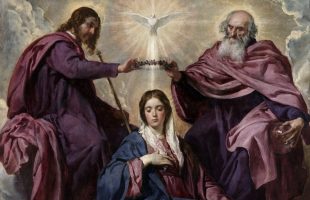
Lesson Objectives
- To understand the biblical foundations of the Dogma of the Assumption.
- To understand the deep Old Testament symbolism and imagery in Revelation 12, and its relation to Catholic beliefs about Mary.
- To appreciate how the biblical portrait of Mary is reflected and interpreted in the Church’s liturgy.
III. From Scripture to Liturgy
A. Summary of Revelation
What do we learn from about Mary in Revelation 12 - and how is this passage related to Catholic belief in her Assumption?
First, we find in Revelation all of the biblical images of Mary that we have discussed in this course. She is portrayed as the new ark of God’s covenant, the new Eve, the Daughter Zion, and the Queen Mother of God’s kingdom.
She is depicted as a virgin mother, giving birth to the Messiah, and as spiritual mother of all those who keep the commandments and bear witness to Jesus.
She is shown to embody or represent all of God’s people. She experiences God’s protection and nourishment in the wilderness of the world and is flown to a place prepared for her by God.
We see, then, the outlines of the biblical foundation for this great Marian doctrine:
Because Mary is the New Eve, envisioned by God since before the garden of Eden to be the ark of His new covenant, to bear God’s only begotten Son, the Author of Life (see Acts 3:15), Mary was protected from the serpent and taken on eagle’s wings to a place prepared for her by God.
B. The Feast of the Assumption
The Church’s interpretation of these biblical texts can be found in the Mass readings for the Feast of the Assumption and for the Vigil of the Assumption, August 14-15.
The vigil for the feast begins with a reading from the first book of Chronicles (see 1 Chronicles 15:3-4, 15-16; 16:1-2) - about David bringing "the ark of the Lord to the place which he had prepared for it."
The psalm for the vigil likewise celebrates this event: "Advance, O Lord, to your resting place, you and the ark of your majesty" (see Psalm 132:8).
The epistle gives thanks for the victory over death won for us by Christ (see 1 Corinthians 15:54-57). The gospel celebrates Mary as not only the mother of Christ, but as one who heard God’s word and believed (see Luke 11:27-28).
The Mass for the feast begins with a reading from Revelation - beginning with the vision of the ark in the heavenly temple (see Revelation 11:19-12:1-6, 10). The psalm depicts a queen standing at the king’s right hand (see Psalm 45), while the epistle envisions Christ as the king putting His enemies under His feet - the last enemy being death (see 1 Corinthians 15:20-27).
Finally, the gospel for the feast is Mary’s visitation of Elizabeth (see Luke 1:39-56) which, as we have explored in earlier lessons, depicts Mary as the ark of the covenant.
In the Assumption liturgies, then, we see the Church identifying as the fulfillment of numerous Old Testament figures. Mary is shown to be the ark of the covenant, bearing the Lord’s presence. And we see her described as Daughter Zion, the new Eve, and the Queen of Heaven.
We also see her as a symbol of the whole people of God. As Revelation describes her offspring as keeping God’s commandments and bearing witness to Jesus (see Revelation 12:17), she is hailed by Jesus herself in the liturgy as "blessed" because she heard the work of God and observed it (see Luke 11:27-28).
Portrayed in the Scriptures as the model of believers and the new Eve, it is fitting that the dogma and the worship of the Church associates Mary with Christ’s victory over death, which came into the world through the first Adam and the first Eve (see 1 Corinthians 15:20-27).
Other Lessons
- Lesson One: A Biblical Introduction to Mary
- To understand the basic outlines of the New Testament’s witness to Mary.
- To appreciate how the Old Testament forms the essential background for what the New Testament teaches about Mary.
- To understand “typology” and its importance for reading the New Testament texts concerning Mary.
- Lesson Two: Wedding at Cana, Garden in Eden
- To appreciate the Old Testament symbolism that forms the deep background to the Gospel account of the wedding feast at Cana.
- To understand how Mary is depicted as a “New Eve” in this account.
- To appreciate the importance of the Old Testament marriage symbolism for John’s recounting of the “sign” at Cana.
- Lesson Three: The Ark of the New Covenant
- To see how Mary’s visit to Elizabeth parallels David’s bringing of the Ark of the Covenant to Jerusalem.
- To understand how the book of Revelation uses the startling image of the rediscovered Ark of the Covenant to introduce a vision of the Mother of Christ.
- To understand why the New Testament writers see Mary as the Ark of the New Covenant.
- Lesson Four: Mother Crowned in Glory
- To see the importance of the Queen Mother in the Davidic kingdom of the Old Testament.
- To understand the duties and privileges that came with the position of Queen Mother.
- To see how Mary fills the position of Queen Mother in the kingdom of Christ.
- Lesson Five: The All-Holy Mother of God
- To understand the relationship between Catholic teaching about Mary and the Scriptural portrayal of Mary.
- To understand the biblical foundations of the Dogma of the Immaculate Conception.
- To appreciate how Catholic belief in the Immaculate Conception flows from the New Testament portrait of Mary as the “New Eve”